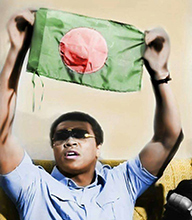
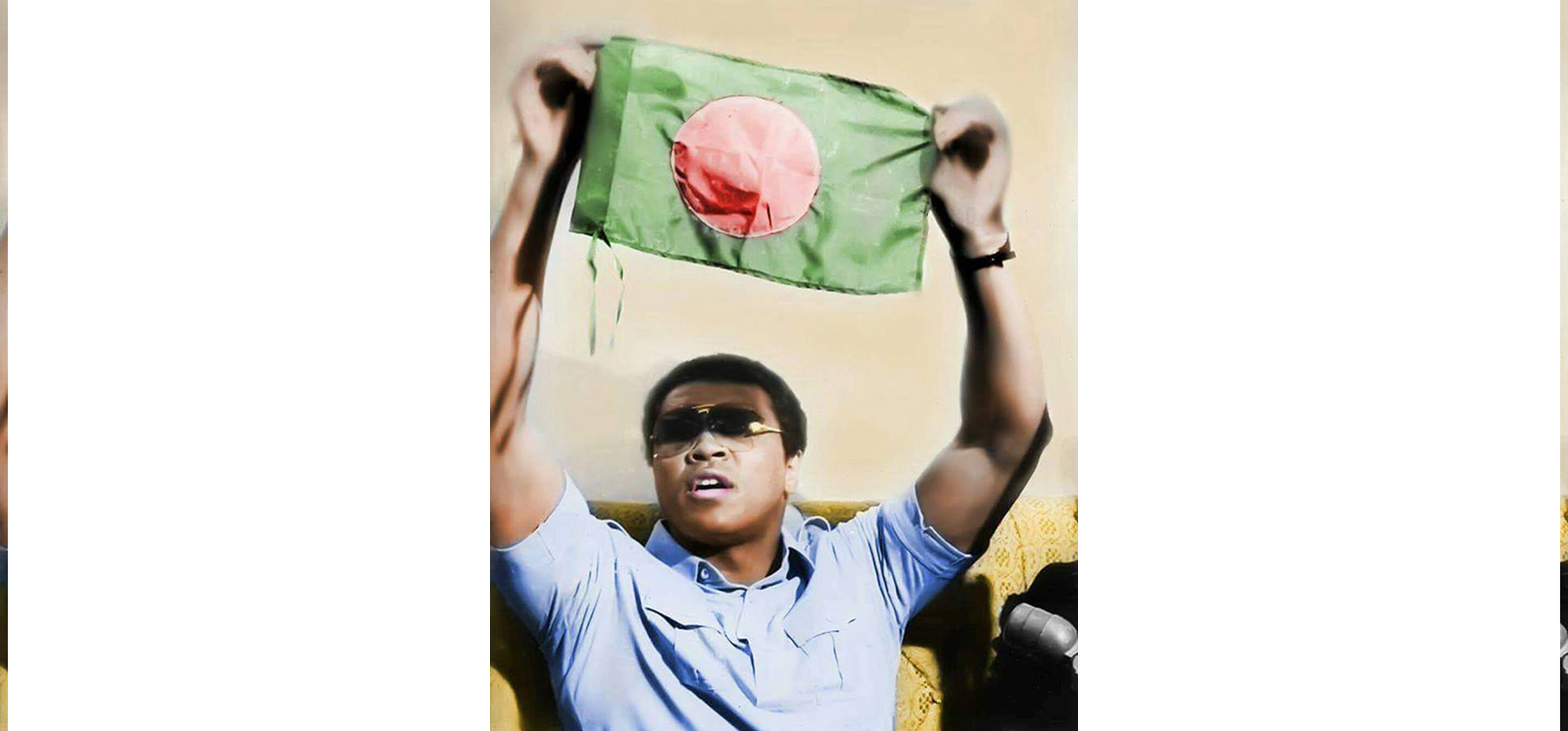
Muhammad Ali holding Bangladesh flag at press conference.
Photo by Md. Lutfur Rahman Binu.

IN 1978, MUHAMMED ALI WAS TRAVELING TO BANGLADESH. Our first sighting of him is inside an airplane, in wide business class seats. He is looking out the window, although the flight has not yet begun its descent. A moment later, the stewardess serves him a glass of orange juice. The officious British narrator, journalist Mark Alexander, sits next to Ali and tells the audience he has the privilege of “accompanying Muhammad Ali on this rare pilgrimage.” (11:04)1 Looking at such an image, one can easily see the boxer, the way he perhaps still saw himself at that time — as a roving Muslim International. Not just a member of the Ummah, that is, but an oppositional cosmopolitan subject that Ali's public persona had helped connect to the Black American experience. In fact, in 1978 we are already too late. The radical possibilities of such a figure have already begun to recede, as the fiery and transformative political possibilities of the 1960s gave way to the reversals and defeats of the later 1970s.

Left: Ali at Dhaka Airport. Right: Ali meets General Ziaur Rahman.
Source: Muhammad Ali Goes East.
Before we have time to ponder the implications of the scene, the grating narration (“Bangladesh lies to the south of China”) guides us to Ali’s first encounter with Bangladesh’s president, General Ziaur Rahman.2 A few moments later, an official presents Ali with a Bangladeshi passport, making him the “country’s newest citizen” (13:27). The dialogue that ensues is revealing.

Ali receiving his Bangladesh passport.
Source: Muhammad Ali Goes East.
Official: “Here is a passport for you…”
Ali: “So I am a citizen of Bangladesh?”
Official: “Yes that’s right.”
Ali: “Can I use this all over the world?”
Official: “Yes, you can.”
Ali: “Thank you so much. Now, if they kick me out of America, I have another home. Thank you.” (13:58)
I wish the camera would pull back, so we could see the Bangla officials’ startled facial expressions. Ali was positioning his new citizenship as an antidote to his relationship with the United States, fraught especially following his refusal to fight in Vietnam and the ostracism that followed. But the exchange was taking place in a country whose geopolitical tilt had recently shifted away from the USSR, drawing closer to American influence.
Perhaps Ali did not properly understand the new reality of the region he was visiting, fixed instead on dream of solidarity between Black Americans and the Muslim Third World. Ali’s entourage may not have thought it necessary to study their destination closely. If they had, they might have learned that the country founded on socialist principles in 1971, after suffering a series of military coups after 1975, was rapidly becoming more conservative Muslim nation. In Bangladesh, Ali was seen as a world class athlete. The live telecast of two of his fights (some of the earliest live transmissions in the new country) made him one of the first foreign celebrities to gain wide recognition in the country.3 His earlier opposition to racism in the United States, and its overseas empire, was little understood inside Bangladesh. Even if it had been, the position would have been an odd fit with the distinctly pro-American sentiment of the government in 1978.
The international reality had started shifting as well. By 1978, the contours of a widely shared, anti-imperialist platform had started to blur. The Vietnam War had ended in a dramatic defeat for the United States, and the White House was occupied by Jimmy Carter, the Nixon antithesis. Although Vietnam had galvanized antiwar protestors, the subsequent war in Cambodia presented a messier geopolitical equation. In the dying sprawl of the Cold War, the transnational crises of Iran and Afghanistan unraveled many more certainties. Ali himself was enervated by financial hardship, years of physical punishment from landed blows, and a long exile from the sport. In the coda to the Bangladesh trip, we find him enthralled by Carter’s “new” America. The Georgia peanut farmer’s ethos (“I’ll never lie to you”) suggested a path of redemption for the American project. Only a little while later Ali's politics would shift too — away from his 1960s critique of empire fueled by America's besieged Black bodies, to an embrace of US exceptionalism at the end of the decade. By then his public persona had transformed from a “dangerous” member of a transnational network to a “goodwill” ambassador for the American presidency.

Before proceeding further with the film, I want to examine the idea of a “Muslim International,” developed by Sohail Daulatzai.4 The concept draws attention to the relationship between intellectual histories of US Black Radicalism, Black Internationalism, Third World decolonization, and the Muslim portions of the Third World — sitting at their intersecting center a four-way Venn diagram. Daulatzai contrasts his idea of a “Muslim International” with race scholar Paul Gilroy’s famous concept of the “Black Atlantic.” Gilroy challenged the idea of a diaspora defined and separated by national origin, instead emphasizing the hybridity of survivors of the Atlantic slave trade, who belonged as a result to both Europe and Africa. But Gilroy’s version of hybridity also sets up a kind of nation-state, because the liminal space of the Black Atlantic still has a many-to-one relationship with America. A “Muslim International” can on the other hand accommodate the multiple and overlapping diasporas resulting from slavery, colonialism, and migration, as well as communities shaped by adversarial relationships with states, capitalism, and imperial power. Instead of a many-to-one relationship with America, the Muslim International allows us to conceptualize a many-to-many relationship. Within this conceptual space, shape shifting and fluid subjectivity are possible.
At the core of Daulatzai’s disagreement with Gilroy is that Black Atlantic does not recognize the role Islam and the figure of the Muslim played in constituting modernity, through its ostracism as modernity’s quintessential Other. Daulatzai points out the sharp absence of Muslim protagonists, movements, and nations in scholarly narratives of Black Radicalism. Building a new history of “unacceptable” or “dangerous” Black figures, Daulatzai reaches back to Malcolm X, forward to Reagan-era hip-hop, and then arrives ringside with Muhammad Ali. In each case, he takes a familiar story and finds within it the Third World Muslim connection. He places Malcolm more firmly in a Third World context, moving away from the Alex Haley version of the story, toward Bandung and Mecca. Drawing on recent research on hip-hop’s early Muslim connections,5 he shows the ways in which hip-hop represents an area of fertile crossover and linkage with global “Ummah” movements, and finally arrives ringside with Muhammad Ali. The boxer rejected the question of allegiance to America, placing his loyalty elsewhere—with the Muslim International. In doing so, Ali brought the idea of a Black world to late 1960s American audiences: “I belong to the world, the Black world. I’ll always have a home in Pakistan, in Algeria, in Ethiopia.”6
Here Ali aligned himself with a force outside and against the United States. While Ali uses the term “Black,” he gestures at Pakistan and visits Bangladesh. In his terminology, Black is an isomorphism for Muslim and Third World. Around the same time, “Black Britain” came to represent the allied movements of Asian and Black migrants against the common opponent of British racism and classism. Ali indicated what was, at least for a limited historical moment, an even more expansive possibility, resonant with Daulatzai’s idea of many-to-many: the Black experience as entry point into the Muslim experience, and vice versa.
Daulatzai said in his book that Ali became a safe figure for American consumption in the 1990's. When I spoke to him about this earlier trip of the 1970's, he wrote back, "In the '70's with his fights in Zaire/Congo and Manila he was going to locations that had very troubling histories with US empire and CIA intervention, and he was at least tacitly affirming Mobutu and Marcos. Now does that mean he was "appropriated" or "recuperated" in the ways that my book says he was in the 90's? I am not sure — I think the 90's was a particular historical moment of 60's revisionism around the culture wars, and post-cold war triumphalism that was entangled with Huntington's thesis. I think something similar was happening with Bangladesh as in Zaire/Congo and Manila, although because he wasn't going there to fight, it wasn't such a global spectacle.”

Let us return to Reginald Massey’s Muhammad Ali Goes East: Bangladesh, I Love You, a travelogue whose stage-managed images invite decoding. The original documentary was made at the request of Bangladeshi business interests and with enthusiastic support from a Bangladesh government eager to project an image of stability overseas. After airing on Britain’s Channel Four, and a screening at the White House, the film’s production company went bankrupt and the documentary disappeared. The film finally reemerged in 2012 when a VHS copy was unearthed and screened at London’s Bangladeshi cultural center, Brick Lane Circle. Today it circulates only through a clandestine recording made by an audience member at that screening.
Ali was visiting a Bangladesh that, by 1978, was entering the second phase of a prolonged crisis of identity. From 1972-1975, the new country was run by founding Prime Minister Sheikh Mujib — popularly called “Bangabandhu” (Friend of Bengal) — and his Awami League [League of the People]. The party’s key principles included socialism and secularism, although there is debate as to how successful they were in implementing either (their main political opponent was the Jatiya Samjtantrik Dal, or National Socialist Party). The 1975 coup resulted in Mujib's murder and the League league's overthrow, and two more coups followed before General Ziaur Rahman came to power in 1977.
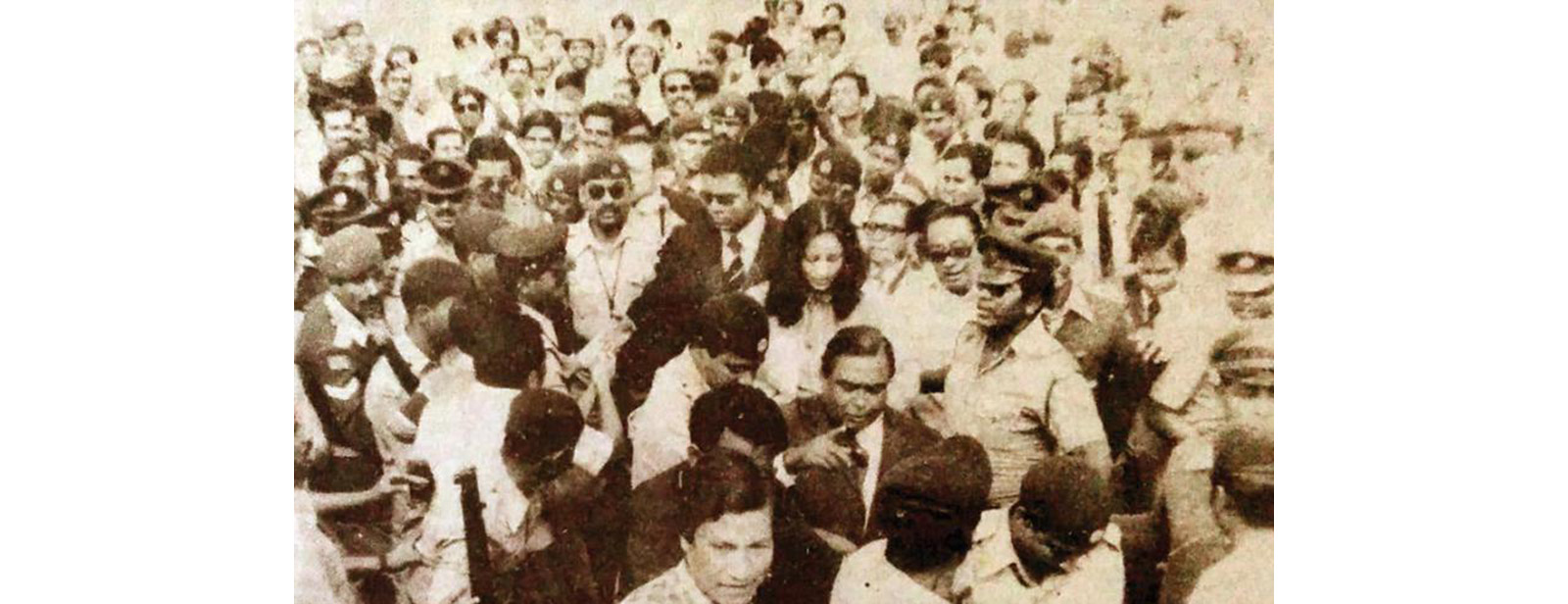
Ali surrounded by military officers as part of his security detail in Dhaka.
Source: Prothom Alo.
Zia's government, like the Bangladesh Nationalist Party he founded, had positioned themselves as the antithesis to the Awami League. “Secularism” and “socialism” were removed from the constitution, a confrontational stance was taken with India, and a closer alignment was sought with both the Muslim world and the United States. By 1977 the political situation had stabilized under the military regime, and an earlier order of business — enhancing the country’s profile abroad — was resumed. The outreach to Reginald Massey was part of the public relations effort. It was in this context in which Muhammad Ali’s trip was arranged, although you would never know it from the film itself.
Massey’s biography says he was born in “Lahore, then in British India.” After moving to London, he wrote books on Indian classical dance. His website tells us “some of his books are standard works and used by international bodies such as New York’s Lincoln Center.” Approached by businessman Giashuddin Chowdhury in 1977 about creating an event that would “boost the image” of Bangladesh, Massey proposed a state visit by Muhammad Ali.
The boxer was by then entering the period of his career's decline, having just been humiliatingly beaten by Leon Spinks. Massey presented the Bangladesh voyage as a tonic to reenergize Ali, because “Ali was very downhearted. We told him that he was still a hero in Bangladesh.” The trip was framed for Ali, as a duty in support of a Third World nation. We see that framing reflected in the boxer's speech to the camera at the beginning of the film:
[I want to] help more people in the world to know about Bangladesh.
One of my goals is to greet all my fans, and do all I can to help more people
in the world to know about Bangladesh. To draw attention to some of the positive
things about Bangladesh; so much negative things have been said. (10:00)

Ali and Veronica on jeep ride.
Source: Muhammad Ali Goes East.
From the moment of the plane’s touchdown, the documentary moves along as an extended travel film, guiding the viewer through tropes of a visit to Bangladesh: the river cruise (the passing crowd in another boat yells “Muhammad Ali/Jindabad [Long Live Muhammad Ali]” (16:28)), the “golden fiber” jute (the camera lingers on two containers marked with destinations of Los Angeles and Savannah), the endangered Sunderban forest, the historic Star Mosque, the Dhakeswary temple, and the Sylhet tea gardens. Along the way were other elements which were not specific to Bangladesh, but were part of the “East” imagery that Ali was dutifully granted: an elephant ride, and, of course, snake charmers (“snakes are poisonous to all but the snake charmers,” (15:17 )). Ali charmed the audience by exuding largesse (to the people in Sylhet he said, “many people could not afford to come to Dhaka, so we came to see you” (30:24)) and his humor (he compared his wife Veronica Ali to a group of women fans by saying “the ladies in this country not as tall as her” (29:50)).

Left: Sabina Yasmin sings "Ali Ali." Right: Exhibition bout with 12 year old Giasuddin, later Bangladesh national champion.
Source: Muhammad Ali Goes East.

Adamjee jute mills bales with two American destinations prominently displayed.
Source: Muhammad Ali Goes East.
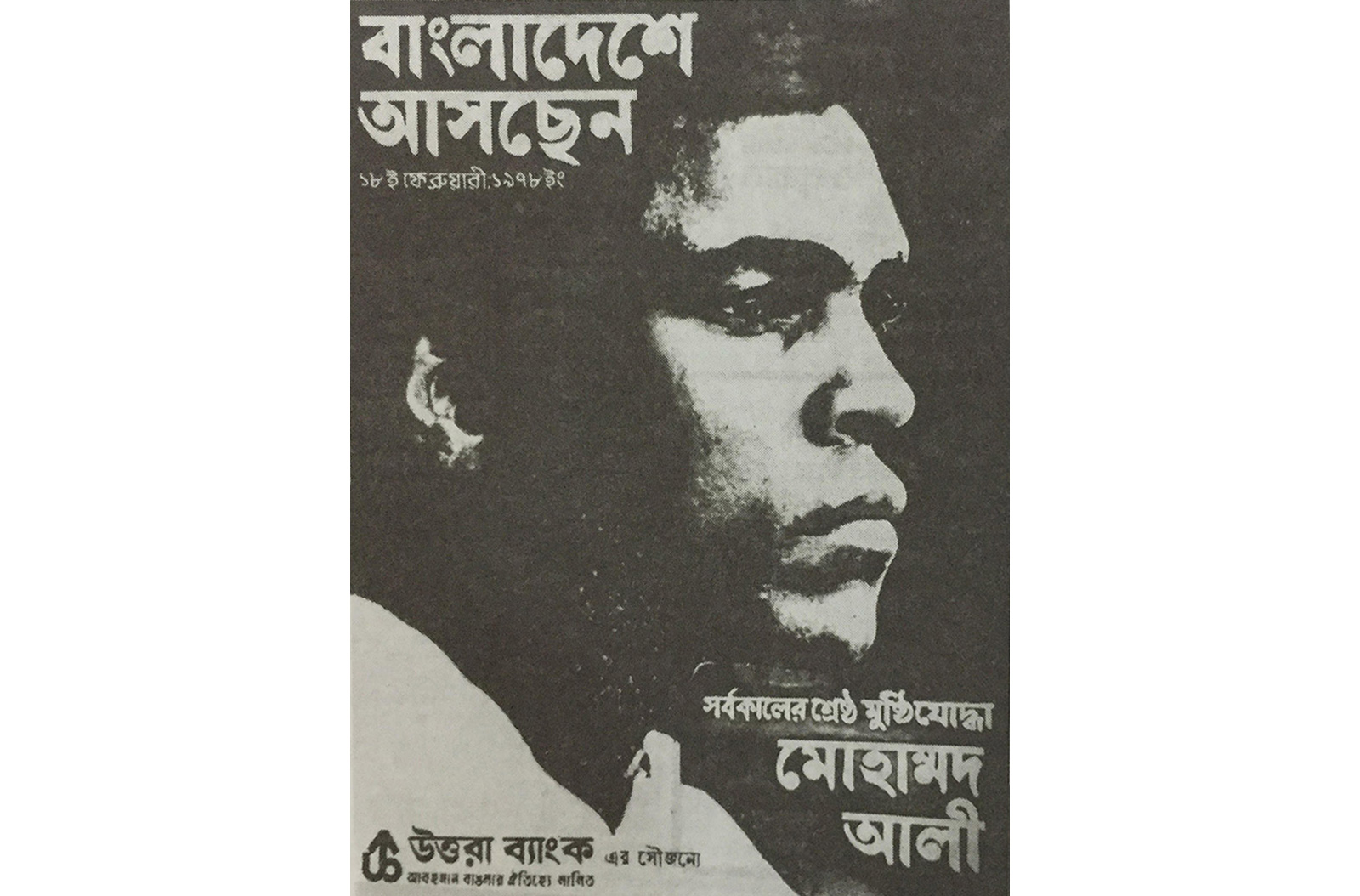
Newspaper advertisement by Uttara Bank, with slogan "Muhammad Ali / 18th February, 1978 /
The greatest boxer of all time/ Is coming to Bangladesh," in Dainik Bangla newspaper.
Source: Lutful Haq, Muhammad Ali'r Bangladesh Bijoy.
By the film’s end, Ali has been given, in addition to a passport, a plot of land in Cox’s Bazaar, and the promise that a boxing stadium in Dhaka would be named after him. He had performed a symbolic bout with twelve year old Mohammad Giasuddin — later the country’s three-time national champion. The state visit ended with a dinner where renowned Bengali singer Sabina Yasmin sang the special composition “Ali Ali” (later released as an album). Two million fans had come out to meet him and they trailed him everywhere on his trip. Business interests were clear in recognizing the branding opportunity, as state-run Uttara Bank took out newspaper advertisements welcoming Ali, in Bengali and English. Driving along the “miles of unbroken beach,” at Cox’s Bazaar, Ali waxed rhapsodic: “We in heaven over here. You want paradise come to Bangladesh … eat at the President’s house” (32:05).

Left: Ali on boat cruise. Right: Ali visiting tea gardens.
Source: Muhammad Ali Goes East.
The Zia government’s project to create a new identity for Bangladesh can be glimpsed too. On the river cruise, people yell “Muhammad Ali/Jindabad [Long Live Muhammad Ali]”, a slogan deeply embedded with ideology. “Bangladesh Jindabad” was a slogan newly popularized by the post-1975 government, identifying the geographic limits of Bangladesh (its implicit separation from West Bengal in India), while evoking the pre-1971 slogan of an undivided Pakistan. Its use was anathema to followers of the pre-1975 Awami League government, which promoted “Joy Bangla” [Long Live Bengal]” during the 1971 war and afterward to indicate linguistic identification as basis for nation. Four decades later, the “Joy Bangla” slogan has returned in a period of resumption of state power by the familial and political heirs of the Awami League. The Bangladesh that Ali visited does not exist anymore, but in 1978 the (possibly stage-managed) slogan “Muhammad Ali Jindabad” establishing “Jindabad” (an Urdu phrase, which the 1971 war with Pakistan should theoretically have made anathema) as the marker of nation. It was simultaneously establishing a new, more market-oriented and more conservative Muslim internationalism as Bangladesh's future path.
If Ali had come to Bangladesh because the country “needed” him in the unstable aftermath of its nationhood —throughout the film he dutifully reminds the camera, “We never get the news in America about how beautiful this place is,” — it was also Ali who needed Bangladesh to revive him after the defeat to Spinks. The film does its best to keep the focus on Bangladesh’s scenery and its place in the world, but Ali also takes refuge from a boxing world that has declared him a spent force. Talking up Bangladesh’s potential, Ali holds his career at a distance, and sounds almost humble, “So much violence in the world, so much killing … I’m a do what I can in my power to tell people [about Bangladesh]” (33:00). Yet, by film’s end, he is raring for a second chance at Spinks and finally explains why he has to wear sunglasses all the time: “[He] gave me a black eye! Can you imagine?” (50:39).

Ali gestures at the remainder of black eye from previous fight.
Source: Muhammad Ali Goes East.

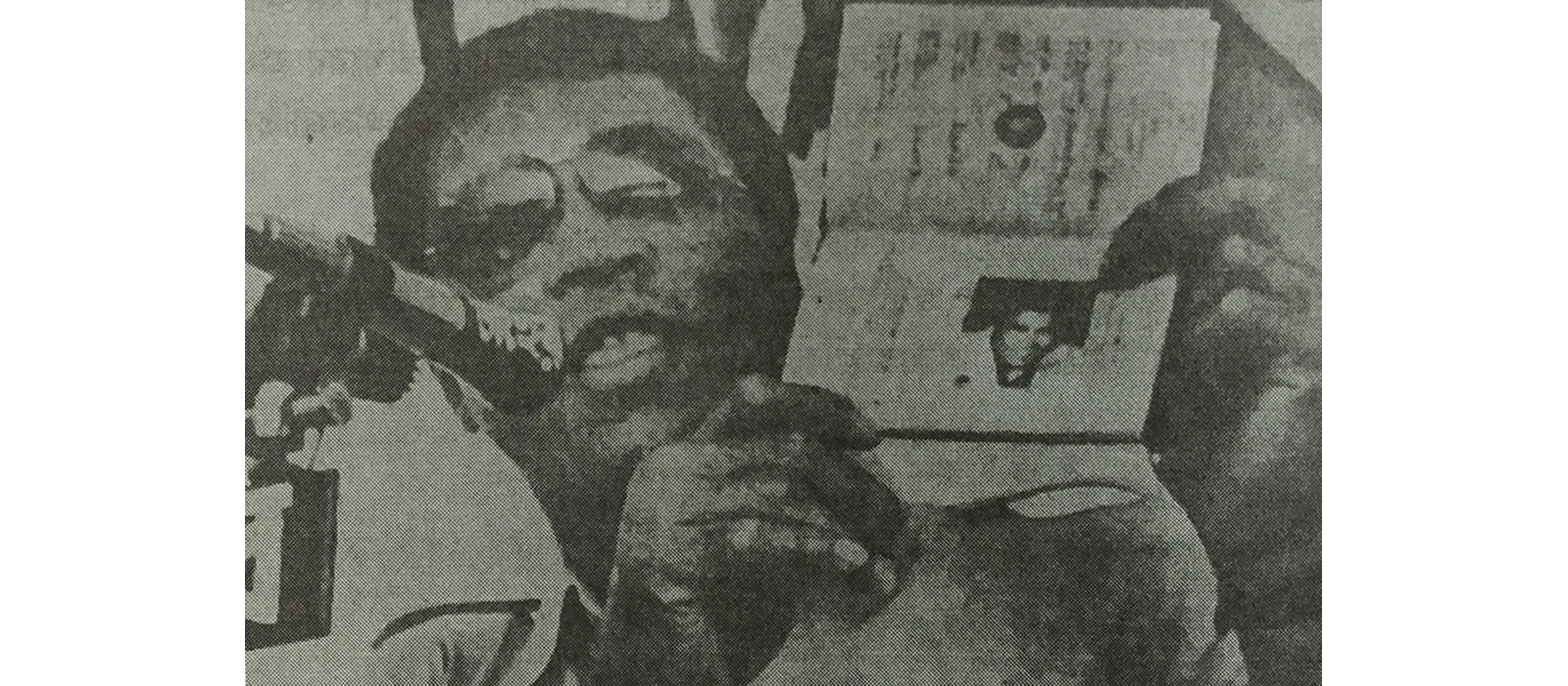
Ali shows his Bangladesh passport.
Source: Lutful Haq, Muhammad Ali'r Bangladesh Bijoy.
Perhaps Bangladesh was to have been one stop on a global tour that would rekindle Ali’s connection with transnational Muslim energies. In the 1960s, his primary site of political activism, as a provocative presence at press conferences, television programs, and campus lectures, had been the American experience. Internationalism had come to him via the Nation of Islam. It manifested resonantly when he cited his Muslim beliefs in refusal to fight in Vietnam in 1967. By the 1970s, he was facing more clearly outward, making a point to reach out to Muslim countries. Ali’s 1972 pilgrimage to Mecca connected him with a multiracial Muslim identity (and echoed Malcolm X’s 1964 trip). His decision to leave the Nation of Islam and embrace Sunni Islam after 1974 made him even more legible and acceptable in countries like Bangladesh.
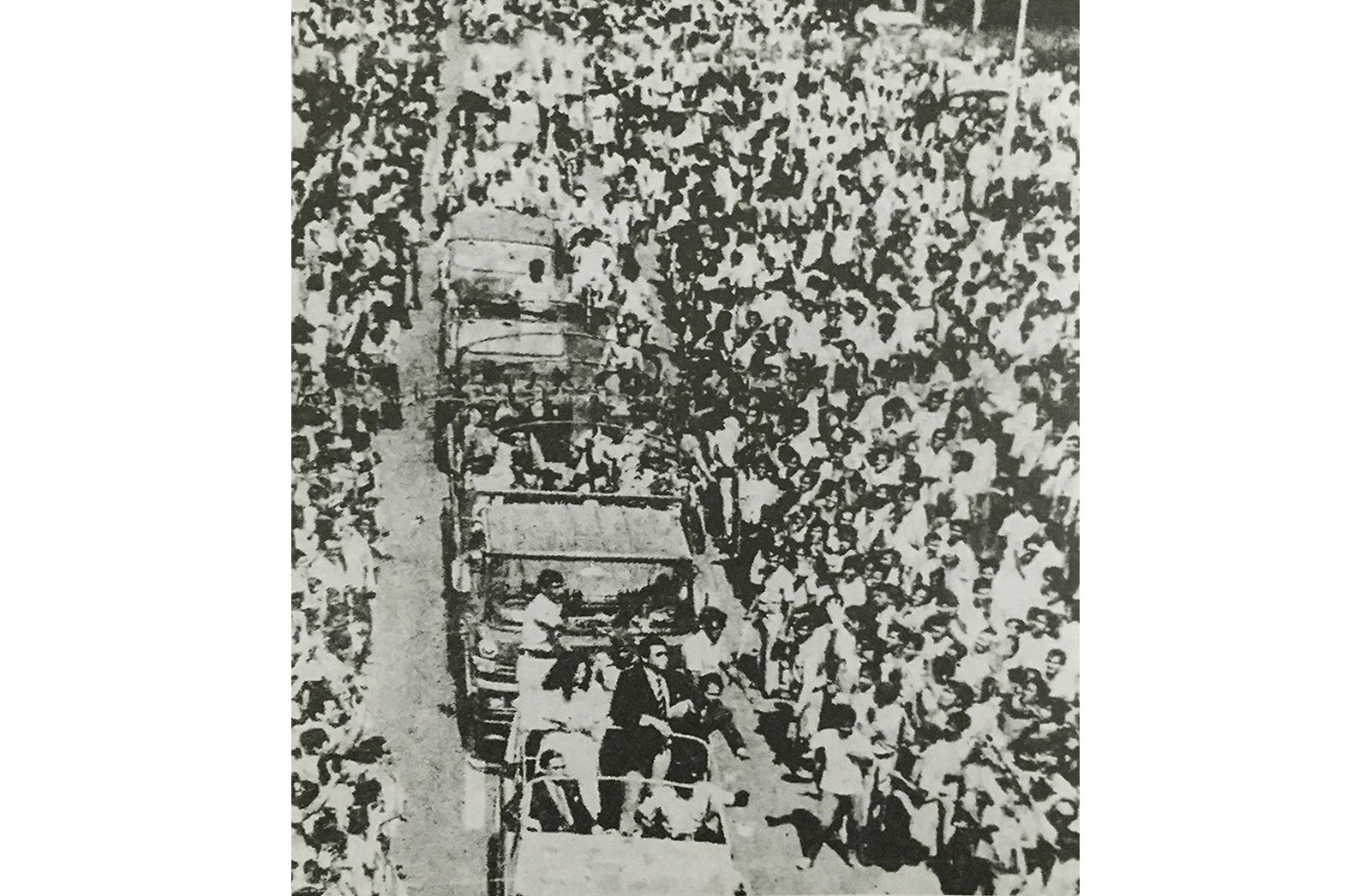
Ali’s motorcade in Dhaka.
Source: Lutful Haq, Muhammad Ali'r Bangladesh Bijoy.
However, there were always unstable elements in this search for a Muslim International. The project implicitly assumed Muslim countries were disposed to be critical of, and resistant to, empire. During the sixties the leadership of the Nonaligned Movement may have made such premises seem uncontroversial.
But not only had Bangladesh’s government become more conservative over the course of the 1970s, the country had become an active member of the Arab nation dominated Organization of Islamic Countries. This bloc, strengthened by the oil crisis, had started to move away from the nonaligned consensus. The realignments of the 1970s increasingly presented the dilemma of the Muslim International in a context where Third World leaders were no longer taking anti-imperialist positions. Journalist Palash Ghosh highlights how uneasy this internationalism would become: “Ali mixed with some questionable characters during his many overseas jaunts, including such bloody despots as Uganda's Idi Amin and Iraqi strongman Saddam Hussein.”7
The boxer’s visits could give Third World nations an “artificial unity,” as Grant Farred puts it in his series on Black vernacular intellectuals.8 Through Ali’s lens, Muslim majority nations were a source for a liberation theology naturally allied with Black radicalism. Cassius Clay’s conversion to Islam had been received ferociously in America; icons like Justice Thurgood Marshall called him “the ugly American” and fellow fighter Floyd Patterson declared that the “Black Muslim scourge” needed to be “removed from boxing.” In response to this domestic reception, Ali’s impulse to seek refuge in the Muslim world was strong, even as it increasingly landed the boxer in complex situations like Bangladesh in 1978.
In the United States, Muhammad Ali’s rehabilitation began with the Carter era and its post-Vietnam zeitgeist of redemption. Once the White House embraced Ali, his position as a US insider deepened. Buoyed by the success of the Bangladesh film, Massey began work on a sequel, which would take Ali to India. Ali was flown there with his entourage in 1980 and, according to Massey, charmed Indira Gandhi with a warm peck on the cheek and a quip: “America kisses Mother India!” The man who once said “separation” was the only solution to America’s racial crisis was now the gentle ambassador for a post-Vietnam administration. The contradictions of Ali’s ambassadorship surfaced halfway through the India filming. One day, while resting at the hotel, Massey received a direct phone call from the White House. After determining that the “Southern gentleman” on the phone was indeed Carter, he passed on the phone to Ali. After a brief conversation, Ali came to Massey and said,
“Brother Reg, My President has ordered me to immediately fly to Africa and
Saudi Arabia. My orders are to tell them all to boycott the Moscow Olympics
because the Russians have invaded Afghanistan, a Muslim country.” (emphasis added)
With that, filming was abandoned — Massey said this helped bankrupt the company — and Ali was on his way to Saudi Arabia, where he was warmly greeted by the King. The Muslim International no longer derived energy from a resistant Third World position, but instead devolved into realpolitik alignments. Ali was now an emissary of the United States against Russia in the Afghanistan crisis, placing himself in the middle of a superpower battle. Perhaps he wanted to believe, with others, that Vietnam was only a wrong turn in foreign policy brought about by individual antagonists at the top. In the redemption script, Carter would right America’s wrongs. Those hopes soon unraveled, as the humiliation in Tehran and the faceoff in Afghanistan contributed to the twin ascendancy of Reagan and Thatcher, and the beginning of the neoliberal moment.
Nothing can diminish the courage of the Ali who said “no Vietcong ever called me n****er.” But it is important to recognize that that explosive moment came from the combination of an extraordinary man, a time of revolutionary possibility, and the transmission of an ideology of anti-imperialism. As the possibilities of the 1960s faded, a defeated era produced failures of judgment. The Afghan war was another Cold War staging ground with no possible benefit to the lives of poor Americans, Black or otherwise. But the Soviet invasion did not produce a moment of global antiwar resistance as in Vietnam, and so the spoils of that conflict went to warlords and puppet masters.
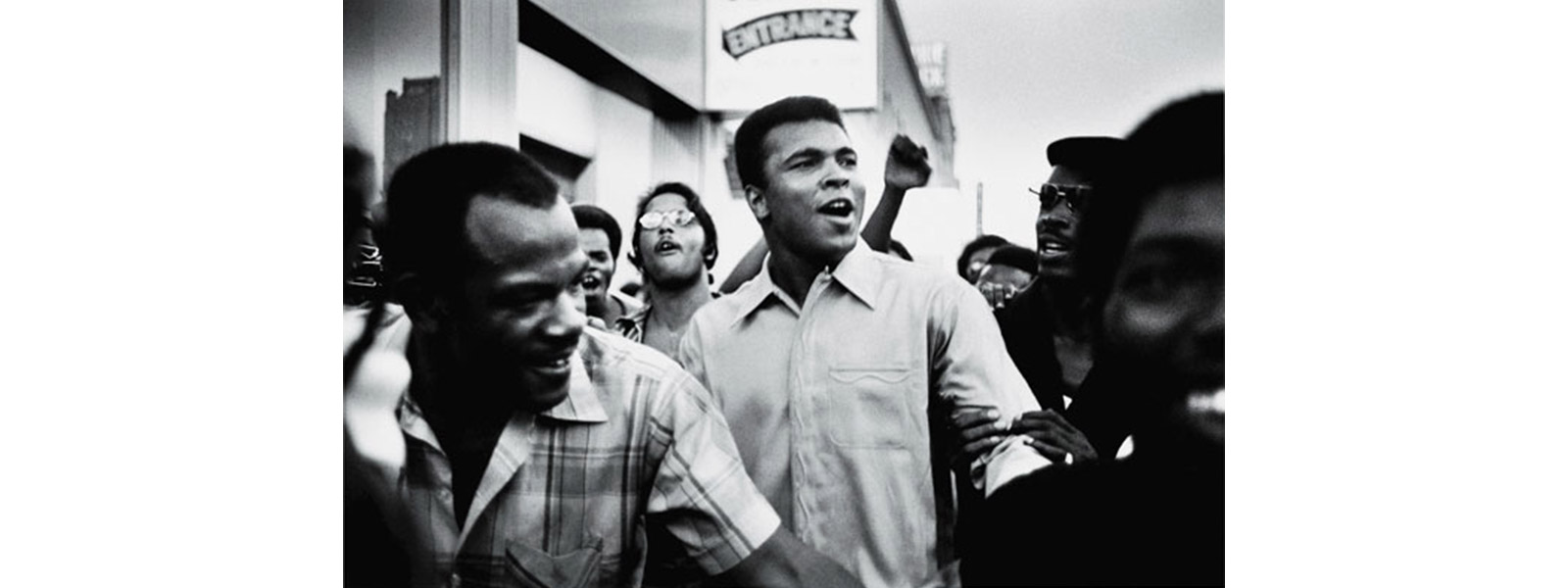
Ali surrounded by supporters. Source: Bill Siegel, The Trials of Muhammad Ali.
Ali’s later experiences do not negate the potency of the Muslim International as a frame for exploring Black radical thought. It does highlight the limitations of the essentialism that guided some earlier alliances. Back in the mid-1960s, events in the US precipitated fractures within Black radicalism, assisted by provocateurs inside and outside the movement. Malcolm X and Elijah Muhammad parted ways dramatically, splitting the strength of Nation of Islam’s membership. The fallout of this event distanced Ali from X as well, separating the fighter from his radical political teacher. Once Martin Luther King started speaking against the Vietnam War and Malcolm returned from Mecca imagining cross-race alliances, they became too dangerous to be allowed to live. With their assassinations, Ali and Black America lost two mentors and the orienting polarization of incremental struggle versus radical resistance. The 1970s saw the waning of the idea of a Muslim International that derived energy and guidance from the African American experience. Over the course of the next decade, the potential of a transnational solidarity network that was more than purely ornamental was gradually eliminated.
Muhammad Ali was a quieter presence in his later years. He described the impact of Parkinson’s’ to his friend Imam Zaid Shakir: “I ran my mouth like nobody else and now God has silenced me.”9 Lawrence Ross’ obituary asks, “So now that he is dead, we have to ask the question as to who gets to decide which Ali voice gets heard and remembered. Which Ali voice, the one that challenged America to be better, or the one that imagines Ali being the silent façade on which he could mean everything to everyone?”10 I want to honor the Ali who helped dismantle the color line, opposed the destructive game of Third World as chessboard, and gave a generation of African Americans the strength to resist and fight back. But I also want to begin to understand the global and domestic forces that produced his moments of misrecognition — his inability to discern authoritarian rule in some of the countries he visited; and his misunderstanding of the Afghan War as simply the invasion of a “Muslim country,” vanishing other possibilities the Afghan people held within themselves. Ali’s later years carry both the scars of sacrificing his body to the “sweet science,” and the loneliness of an African American living on after revolutionary possibilities had again been stolen from his people.
![]()
Naeem Mohaiemen ([email protected]) explores borders, wars, and belonging through essays and film. His essays include “Fear of a Muslim Planet: Islamic roots of hip-hop” (Sound Unbound: Sampling Digital Music and Culture, MIT Press, 2008) and his most recent film is “Abu Ammar is Coming” (Experimenter & Lux, 2016).
![]()
1. Quotations from Muhammad Ali’s Bangladesh visit are from Reginald Massey's documentary Muhammad Ali Goes East: Bangladesh, I Love You (1978). Massey left the production company after a disagreement, and the company itself went bankrupt. The circulating copy is a clandestine recording made by an audience member during a screening at Brick Lane Circle, London. Time codes given here are of the London recording.
2. For a detailed description of Muhammad Ali’s Bangladesh trip, see Mohammad Lutful Haq’s Muhammad Ali’r Bangladesh Bijoy [Muhammad Ali Wins Bangladesh], Prothoma Publishers: 2016. The book was published after Ali’s death.
3. For a brief description of the impact of these live telecasts, see chess grandmaster Niaz Morshed’s article on meeting Ali, Prothom Alo, June 6, 2016.
4. Daulatzai, Sohail. Black star, crescent moon: The Muslim international and black freedom beyond America. University of Minnesota Press, 2012.
5. Aidi, Hisham. "'Verily, there is only one hip-hop Umma': Islam, cultural protest and Urban marginality," Socialism and Democracy, Volume 18, Issue 2, 2004.; Banjoko, Adisa. Lyrical Swords: Hip Hop and Politics in the Mix. YinSumi Press, 2004.; Dasulatzai, Sohail and Dyson, Michael Eric. Born to Use Mics: Reading Nas's Illmatic. New York: Basic Civitas Books, 2009.; Mohaiemen, Naeem. "Fear of a Muslim Planet: Hip-Hop's Hidden History," Sound Unbound: Sampling Digital Music and Culture. Ed. Paul D. Miller. MIT Press, 2008.
6. Marqusee, Mike. Redemption Song: Muhammad Ali and the Spirit of the Sixties. Verso Books, 2005.
7. Ghosh, Palash. “Muhammad Ali In Bangladesh: 35 Years Ago The Champ Visited A New Nation In Turmoil.” International Business Times, August 12, 2013.
8. Farred, Grant. What's my name?: organic and vernacular intellectuals. University of Minnesota Press, 1997.
9. Burke, Daniel. “Why Muhammad Ali was 'the greatest' American Muslim.” CNN, June 7, 2016.
10. Ross, Lawrence. “A Silenced Ali Was a Likeable Ali for White People.” The Root, June 4, 2016.
